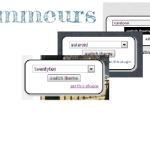Humanized History Plugin for Wordpress - Rating, Reviews, Demo & Download

Plugin Description
This plugin implements a “Humanized History” feature for WordPress
archives, using some PHP glue on the back end and some unobtrusive
JavaScript on the front-end. In JavaScript-enabled browsers, Humanized
History eliminates the need for users to click on “previous posts” links to
read back through your archives; instead, when users get near the bottom of
the current page of posts, the included JavaScript automatically displays
more posts for them at the bottom of the page, providing a magic endless
scrollbar that scrolls through your entire archives, in place of traditional
page chunking.
Search robots and browsers without JavaScript enabled will see the same old
pages with previous page/next page links, so you lose nothing in accessibility
or friendliness to search engines.
The plugin was inspired by the discussion of the concept by Aza Raskin at
Humanized (2006-04-25): No More Pages?. To see a sample of the feature as
implemented in WordPress, go to http://projects.radgeek.com/ and scroll down
toward the bottom of the page.
Don’t make your readers ask you for more content. Just give it to them.
Templates and Styling
If your index.php and archive.php templates provide previous page / next
page links at the bottom of the content, you will probably want to remove these
links from your templates. The plugin automatically provides its own previous
page / next page links at the bottom of the front page and archive pages.
Many WordPress templates (including the default “Kubrick” template) display
posts differently depending on whether they are in archives or in search
results. “Kubrick,” for example, doesn’t display the post’s contents in search
results. If you want to keep different formats for displaying archives as
against search results, then use code something like this in your
template_post_display() function:
function template_post_display () {
if (is_search()) {
// display post for paged search results
} else {
// display post for paged archives
}
}
You may also want to add some styling to your template’s stylesheet for the
navigation links that the plugin automatically generates. Here is what I use to
display the “older posts” link at the far left side of the content column, and
the “newer posts” link at the far right side on the same line:
#content .navigation {
display: block; position: relative; list-style: none;
text-align: center;
margin-top: 10px; margin-bottom: 60px; margin-left: 0px; margin-right: 0px;
padding: 0;
}
#content .navigation .prev {
display: block; position: relative; list-style: none;
top: 0; bottom: auto; left: 0; right: auto; width: 45%;
margin: 0; padding: 0;
text-align: left;
}
#content .navigation .next {
display: block; position: absolute; list-style: none;
top: 0; bottom: auto; left: auto; right: 0; width: 45%;
margin: 0; padding: 0;
text-align: right;
}
If you want to change the appearance of the “Getting more content for you…”
status indicator, then add a rule to your CSS stylesheet for the class
humanized-history-getting-more. E.g., to create a dark translucent box that
floats over the footer material below:
.humanized-history-getting-more {
position: absolute;
width: auto; height: auto;
border: 3px solid #505050;
padding: 0.25em 1.0em;
background-color: #777777;
opacity: 0.85;
z-index: 10000;
}<h3>Feedback</h3>
Comments, questions, applause, brickbats, and bug reports should be directed to
Charles Johnson at technophilia@radgeek.com. Other ways to get in touch with
me can be found through my web page at http://radgeek.com/contact. If you have
a bug or odd behavior to report, please be sure to include as much of the
following information as you can ascertain:
- The version of the Humanized History plugin you are using
- The version of WordPress you are using
- The version of PHP that you are using
Enjoy!
License
The Humanized History for WordPress plugin is copyright © 2007-2008 by Charles
Johnson. This program is free software; you can redistribute it and/or modify it
under the terms of the GNU General Public License as published by the Free
Software Foundation; either version 2 of the License, or (at your option) any
later version.
This program is distributed in the hope that it will be useful, but WITHOUT ANY
WARRANTY; without even the implied warranty of MERCHANTABILITY or FITNESS FOR A
PARTICULAR PURPOSE. See the GNU General Public License for more details.
Screenshots
No screenshots provided



